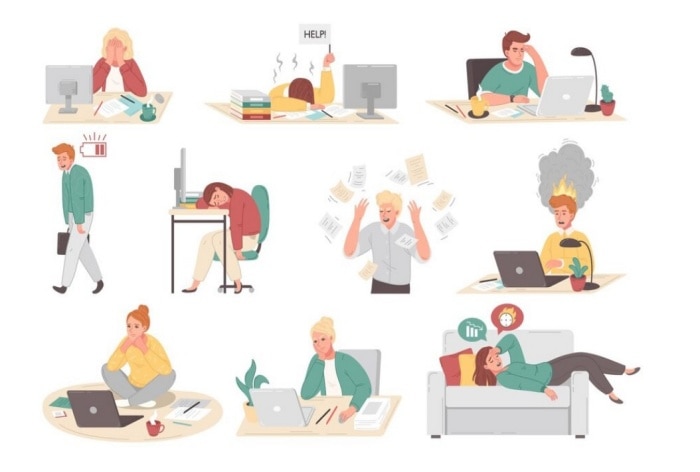Burnout is a real thing and it can severely impact ones overall health. How to identify when a person is feeling burned out? Here are few signs and symptoms and ways to cope with it.
World Mental Health Day 2023: Stress, anxiety, depression. These are some common terminologies that find their way into everyday conversation. Another new term that GenZ often talks about is the feeling of ‘burnout’. But how well do we really comprehend these terms that are often interchangeably used? As we celebrate World Mental Health to spread more awareness about it, let us also take a minute to understand what exactly is burnout and how to deal with it.
WHAT IS BUROUT?
Burnout is a state of chronic physical and emotional exhaustion, often accompanied by cynicism and detachment caused by prolonged stress, overwork, or an imbalance between responsibilities and resources. It occurs when the demands placed on an individual exceed their ability to cope effectively. This state of chronic stress can affect anyone, especially those in demanding jobs or caregiving roles. Burnout is not just a temporary feeling of being tired or overwhelmed; it’s a complex syndrome that can have serious consequences on one’s physical and mental health.
Being burnt out means experiencing a profound sense of disillusionment and feeling depleted of physical and emotional energy. It manifests as a lack of motivation, reduced efficiency, and an overwhelming sense of hopelessness. Individuals experiencing burnout often distance themselves mentally and emotionally from their responsibilities, leading to a decline in overall performance and satisfaction in both personal and professional life.
BURNOUT SIGNS AND SYMPTOMS
Chronic fatigue, persistent headaches, and gastrointestinal issues like stomach pain or digestive problems are some common issues that people deal with.
- Emotional Exhaustion: Feeling emotionally drained, depleted, and detached from work and other responsibilities.
- Reduced Performance: Decline in productivity, increased errors, and difficulty concentrating on tasks.
- Cynicism and Detachment: Developing a negative and cynical attitude towards work, colleagues, and life in general.
- Lack of Satisfaction: Despite accomplishments, there’s a persistent feeling of dissatisfaction and a sense of unfulfillment.
- Changes in Sleep and Appetite: Insomnia, difficulty falling asleep, or sleeping excessively. Changes in eating habits, such as loss of appetite or overeating.
- Isolation: Withdrawing from social activities, avoiding colleagues, friends, and family.
- Increased Irritability: Short temper, impatience, and low tolerance for frustration, even in minor situations.
- Avoidance of Communication: Avoiding conversations, becoming unresponsive, and isolating oneself from friends, family, and colleagues.
- Cognitive Difficulties: Difficulty in concentrating, making decisions, and remembering things.
HOW TO IDENTIFY BURNOUT AT THE WORKPLACE?
- Constant Exhaustion
- Loss of Interest
- Increased Absenteeism:
- Difficulty Concentrating
- Negative Attitude
- Social WithdrawaL
TIPS TO COPE WITH BURNOUT
- Practice Mindfulness and Relaxation Techniques: Incorporate mindfulness meditation, deep breathing exercises, or yoga into your daily routine. These practices can help reduce stress, improve focus, and promote a sense of calm.
- Delegate and Prioritise: Learn to delegate tasks at work and in your personal life. Prioritize your responsibilities and focus on what truly matters. Avoid micromanaging and trust others to handle tasks effectively.
- Engage in Creative Outlets: Pursue creative activities that bring you joy, such as painting, writing, music, or crafting. Creative expression can serve as a therapeutic outlet, allowing you to channel your emotions positively.
- Set Realistic Goals: Break down your tasks into smaller, achievable goals. Avoid setting unrealistic expectations for yourself, both in terms of workload and personal accomplishments. Celebrate your small victories along the way.
- Take Regular Breaks: Schedule short breaks throughout your workday to relax and recharge. Use this time to stretch, take a short walk, or engage in activities that bring you joy. Stepping away from your work can improve productivity and overall well-being.
- Learn to Say No: Avoid overcommitting yourself. Assess your current obligations and decline additional tasks or projects if you feel overwhelmed. Saying no is not a sign of weakness; it’s a sign of self-awareness and healthy boundaries.
- Seek Professional Help: If your burnout symptoms persist or worsen, consider consulting a mental health professional. Therapy, counselling, or coaching can provide tailored strategies to address your specific challenges and help you navigate through difficult times.
- Engage in Physical Activity: Regular exercise not only improves your physical health but also boosts your mood and reduces stress. Find an activity you enjoy, whether it’s jogging, dancing, or practicing a sport, and incorporate it into your routine.
Burnout is not a sign of weakness, it’s a signal that something in your life needs attention and adjustment.

